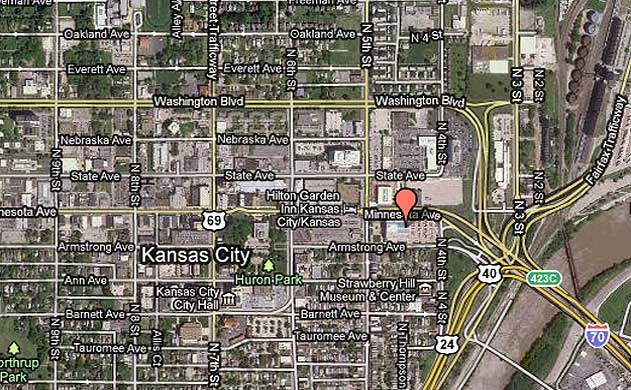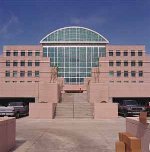Cross-posted from the Natural Resources Defense Council.
In defiance of the environmental values it supposedly stands for, the federal Environmental Protection Agency is moving its regional headquarters from a walkable, transit-rich, downtown Kansas City (Kan.) neighborhood to one of the worst examples of suburban sprawl it could have possibly found, some 20 miles from downtown. The result could nearly triple transportation carbon emissions associated with the facility.
In addition, around 600 federal and associated civilian employees will abandon a central city at a time when the agency’s own staff is writing reports suggesting that central cities in the U.S. are making a comeback. Kansas City, Kan. (population 145,786), is much smaller than neighboring Kansas City, Mo.; the loss of 600 downtown jobs is a major blow to the city’s efforts to strengthen its core.
This decision is horrible in so many ways that it’s hard to know where to start. How the hell did EPA Administrator Lisa Jackson sign off on this?

Let’s look at the facts. The satellite image above shows the location of the current Region 7 headquarters in downtown Kansas City, Kansas. It’s not perfect when viewed through a smart growth and sustainable communities lens, but it’s not bad.
Now consider the new location, a low-rise “landscraper” of a building fronted by large parking lots outside of a suburb called Lenexa, and across the road from, among other things, a wheatfield.

I ran the addresses for the current and new facilities through Walk Score and Abogo, the calculator developed by the Center for Neighborhood Technology that estimates carbon emissions (and household costs) from transportation by location. Above, the EPA’s current headquarters location gets a Walk Score of 62, better than 81 percent of Kansas City as a whole. You can see the locations of nearby amenities on the Walk Score map, which also identifies six bus transit lines within a quarter mile walk of the facility.
Abogo calculates that an average resident in the vicinity of the current EPA Region 7 headquarters emits 0.39 metric tons of carbon dioxide per month, slightly more than half the regional average of 0.74 tons per month. Symbolically, it’s a great location for an agency that is attempting to address global warming. All that yellow and green on the map indicates that the average transportation costs associated with residences in the area are below the regional average.
(Abogo doesn’t directly calculate emissions and costs associated with commercial and civic facilities, but one can extrapolate that the differences between good- and poor-performing locations would be even greater because of the number of visitors associated with commercial and civic locations.)
Now let’s compare the same calculations and maps for the sprawl site to which the EPA intends to move. The Walk Score is only a “car-dependent” 28. That is not only far below that of the downtown location and the average for Kansas City sites; it is also far below the average even for the fringe suburb of Lenexa, 86 percent of whose residents are said to have a higher score. You could see all the nearby amenities on the Walk Score map — if there were any. Sheesh.
But, wait, it gets worse. Abogo calculates that the transportation carbon emissions associated with the new location are a whopping 1.08 metric tons per person per month. That’s nearly three times the average associated with the current location and one and a half times the regional average. This is not just some random corporation making a crappy location decision: This is the agency charged with protecting the environment for the United States of America.
(Ironically, EPA’s new regional headquarters did, in fact, recently belong to a corporation. The agency apparently decided that, if the site was once good enough for Applebee’s corporate honchos, it’s good enough for us.)
When the EPA joined the Department of Housing and Urban Development and Department of Transportation in the federal Partnership for Sustainable Communities, I applauded them. When the partnership issued its first-year report of achievement amidst an impressive array of actions to support local sustainability efforts, I applauded them again. Here’s one of the six core “livability principles” that the EPA pledged to uphold as a participant in the partnership:
Support existing communities. Target federal funding toward existing communities — through strategies like transit-oriented, mixed-use development, and land recycling — to increase community revitalization and the efficiency of public works investments and safeguard rural landscapes.
How’s that promise to support transit-oriented, mixed-use development, and community revitalization looking now, Administrator Jackson?
As for the commitment to “safeguard rural landscapes,” the area of sprawling office space where the EPA will be relocating is, in fact, rapidly converting agricultural land to pavement. Directly across the road from the EPA facility is another low-rise office park whose building footprint is dwarfed by the size of surface parking built to accommodate it. But adjacent to that property is farmland.
And it’s not just the principles of the sustainability partnership that the agency has decided to ignore. The EPA is also thumbing its nose at a series of federal executive orders that clearly establish government policy with regard to facilities location. In particular, on Oct. 5, 2009, President Obama signed Executive Order 13514 [PDF], “Federal Leadership in Environmental, Energy, and Economic Performance.” That order makes it the policy of the United States of America for federal agencies to “reduce their greenhouse-gas emissions from direct and indirect activities.” As shown above, this move will increase those emissions, not reduce them.
More specifically with regard to the siting of federal facilities, the order establishes mechanisms to accomplish the following:
- “Ensuring that planning for new Federal facilities or new leases includes consideration of sites that are pedestrian-friendly, near existing employment centers, and accessible to public transit, and emphasizes existing central cities and, in rural communities, existing or planned town centers”
- “The recommendations shall be consistent with principles of sustainable development including prioritizing central business district and rural town center locations, prioritizing sites well served by transit, including site design elements that ensure safe and convenient pedestrian access, consideration of transit access and proximity to housing affordable to a wide range of Federal employees, adaptive reuse or renovation of buildings, avoidance of development of sensitive land resources, and evaluation of parking management strategies.”
Silly me, I had assumed that the EPA actually had something to do with drafting this order for the President to consider and sign. Now I wonder if the agency has even bothered to read it.
If this matter is litigated, which I’m starting to think might not be a bad idea, could the EPA’s lawyers find loopholes enabling the agency to avoid the intent of the order? Maybe. But the fact that the nation’s most important environmental institution would be resorting to find reasons to escape sustainability practices that both it and the nation’s chief executive have indicated are important says all we need to know about what a mockery of principle this decision is.
And that’s not the only relevant executive order, by the way. Then-President Clinton signed Executive Order 13006, “encouraging the location of Federal facilities in our central cities.” Then-President Carter issued Executive Order 12072, requiring federal location decisions to “conserve existing urban resources and encourage the development and redevelopment of cities” and “give first consideration to a centralized community business area and adjacent areas of similar character.” These directives, as with President Obama’s, are still in effect. (Even then-President Nixon issued an order to “protect and enhance the cultural environment” through historic preservation.)
Officials in Kansas City are not happy about the EPA’s abandonment of downtown, as you might imagine. Neither is former Kansas senator and GOP presidential candidate Bob Dole, who helped Kansas City secure the building that now houses the Region 7 staff and was built specifically for them. Dole, who now represents the owners of the downtown building, pointed to its importance to the city’s revitalization in an opinion column in the Kansas City Star:
The EPA building, which remains in pristine condition, has anchored the revitalization and growth of downtown Kansas City, driving out much of the blight and crime that once plagued this community. About 550 federal government employees and 122 private employees work at Region VII headquarters.
Several years ago the EPA, making a further commitment to Kansas City, located its technical laboratory a block from headquarters to facilitate operations and movement of employees between the offices …
The federal government should also contemplate the effects a move will have on Kansas City. Traditionally the federal government has supported choosing urban sites for federal facilities taking into consideration the economic, social, and cultural conditions, public transportation, and the economic development and employment opportunities in the area.
Put another way, insofar as this matter is concerned, Bob Dole appears to care more about urban sustainability than the Obama administration’s EPA. (See more coverage of the opposition to EPA’s decision here, here, and here.)
The decision to abandon the city and exacerbate suburban sprawl was ostensibly made to save money, though one might ask whose money, since employee and visitor commuting costs to the sprawl site will be substantially higher than they are now for the central location. In any event, although the lease in the new location will be heavily discounted for the first year, over the length of the lease costs will likely be higher in the new location than they would be under a new long-term lease for the downtown property.
A second argument advanced in favor of the sprawl site is, ironically, that the former Applebee’s building is LEED-certified, while the current building, which was built to then-prevailing green standards in 1998 but predates LEED, is not. If that is the real reason, it more than anything else I have come across illustrates the perversity of LEED building standards that largely ignore the environmental consequences of location. Research shows that transportation energy use and emissions of purportedly green buildings, when they are placed in sprawl, wipe out any benefits conferred by the technology of the buildings themselves. I’ve written about that repeatedly.
EPA’s partner in the federal sustainability partnership, HUD, has said that it is going beyond the old LEED standards and beginning to adopt the principles of location efficiency and the new-generation LEED for Neighborhood Development, which emphasizes not just internal building characteristics but also the locational context of development. Has HUD now surpassed the EPA as the federal government’s environmental leader? I wouldn’t be the first to suggest that it has.
Moreover, the federal Department of Energy says that the current, downtown building has plenty of green features:
The building is situated on a brownfield site and was planned from the beginning to serve as a model for economically and environmentally sustainable building practices.
Every aspect of this building’s design, construction, operation, and maintenance was considered for sustainable applications and practices. Water conservation is achieved through native landscaping and low-flow interior fixtures. Building materials were selected for their recycled content and their contribution to a healthy indoor environment. Strategies for energy conservation range from siting decisions and the use of daylighting to efficient HVAC components.
The owner of the downtown building has said that it is willing to obtain LEED-gold certification for the building’s operation and maintenance, at its own expense, within a year.
In today’s rancorous political climate, conservatives charge that the federal government’s interest in sustainability is basically a statist plot to force Americans into a lifestyle that they don’t want. To them I say, rest easy, my friends; go back to fighting that other statist plot, decent health care for all Americans. You have absolutely nothing to fear from this one.
Amazingly, in this case it is by ignoring sustainability that the government may be forcing its employees into a lifestyle and increased costs that they likely do not want. The much-heralded government interest in sustainability not only is not forcing ordinary Americans to do anything: It isn’t even having an effect on the government’s own practices.



